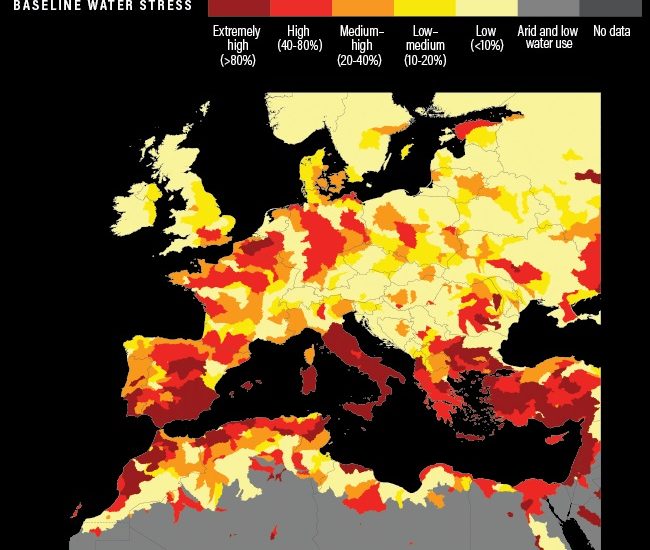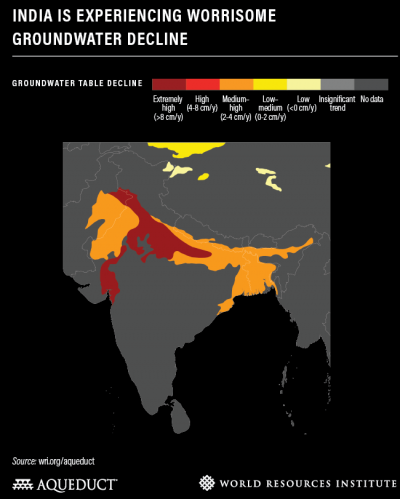New data shows Middle East and North Africa is the most water-stressed region on earth
- August 7, 2019
- Posted by: Elaine Coles
- Category: Agriculture, Global, Water Issues, Middle East

New data published by the World Resources Institute shows that the Middle East and North Africa (MENA) is the most water-stressed region on earth.
According to the data, water withdrawals globally have more than doubled since the 1960s due to growing demand and 17 countries – home to one-quarter of the world’s population—face “extremely high” levels of baseline water stress.
Through new hydrological models, WRI found that water withdrawals globally have more than doubled since the 1960s due to growing demand – and they show no signs of slowing down.
New data from WRI’s Aqueduct tools reveal that 17 countries – home to one-quarter of the world’s population—face “extremely high” levels of baseline water stress, where irrigated agriculture, industries and municipalities withdraw more than 80% of their available supply on average every year.
Middle East and North Africa (MENA) is the most water-stressed region on earth
Twelve out of the 17 most water-stressed countries are in the Middle East and North Africa (MENA). The region is hot and dry, so water supply is low to begin with, but growing demands have pushed countries further into extreme stress. Climate change is set to complicate matters further: The World Bank found that this region has the greatest expected economic losses from climate-related water scarcity, estimated at 6-14% of GDP by 2050.
However, WRI says there are untapped opportunities to boost water security in MENA. About 82% of the region’s wastewater is not reused; harnessing this resource would generate a new source of clean water. Leaders in treatment and reuse are already emerging: Oman, ranked #16 on the list of water-stressed countries, treats 100% of its collected wastewater and reuses 78% of it. About 84% of all wastewater collected in Gulf Cooperation Council countries (Bahrain, Kuwait, Oman, Qatar, Saudi Arabia and the United Arab Emirates) is treated to safe levels, but only 44% goes on to be reused.
Forty-four countries, home to one-third of the world, face “high” levels of stress, where on average more than 40% of available supply is withdrawn every year.
According to WRI, such a narrow gap between supply and demand leaves countries vulnerable to fluctuations like droughts or increased water withdrawals, meaning more and more communities are facing their own “Day Zeros” and other crises.
WRI said that water stress is poised to worsen unless countries act, with population growth, socioeconomic development and urbanization increasing water demands.
WRI has highlighted three other trends from the data:
India’s water stress goes beyond the surface

India’s water challenges extend beyond current events in Chennai. Last year, the National Institution for Transforming India (NITI Aayog), a government research agency, declared that the country is “suffering from the worst water crisis in its history, and millions of lives and livelihoods are under threat.” Aqueduct’s findings put this crisis in context: India ranks 13th for overall water stress and has more than three times the population of the other 17 extremely highly stressed countries combined.
The new Aqueduct data includes both surface and groundwater stress for the first time. In addition to rivers, lakes and streams, India’s groundwater resources are severely overdrawn, largely to provide water for irrigation. Groundwater tables in some northern aquifers declined at a rate of more than 8 centimeters per year from 1990-2014.
India is starting to take critical steps to mitigate water stress, including setting up the Jal Shakti Ministry to prioritize all water issues—including supply, drinking water and sanitation—under one national government umbrella. Other solutions the country could pursue include more efficient irrigation; conserving and restoring lakes, floodplains, and groundwater recharge areas; and collecting and storing rainwater.
Pockets of extreme water stress exist even in countries with low overall water stress
In addition to ranking countries’ water stress, Aqueduct includes data at the sub-national and sub-watershed levels.
WRI said it is clear that even in countries with low overall water stress, communities may still be experiencing extremely stressed conditions. For example, South Africa and the United States rank 48 and 71 on WRI’s list, respectively, yet the Western Cape (the state home to Cape Town) and New Mexico experience extremely high stress levels. The populations in the two states rival those of entire nations on the list of most water-stressed countries.
Water stress is not a destiny
The WRI is emphasising that water stress is just one dimension of water security and points out that like any challenge, its outlook depends on management. Even countries with relatively high water stress have effectively secured their water supplies through proper management, for example:
Saudi Arabia, ranked 8 for water stress, prices water to incentivize conservation. Its new Qatrah (“droplet” in Arabic) program sets water conservation targets and aims to reduce water usage 43% within the next decade.
Namibia, one of the most arid countries in the world, has been turning sewage water into drinking water for the past 50 years.
Australia nearly halved domestic water use to avert its own Day Zero moment during the Millennium Drought. The country’s water-trading scheme, the largest in the world, allows for smart allocation of water among users in the face of variable supplies.
Three ways to reduce water stress
In any geography, water stress can be reduced by measures ranging from common sense to cutting-edge. There are countless solutions, but here are three of the most straightforward:
- Increase agricultural efficiency: The world needs to make every drop of water go further in its food systems. Farmers can use seeds that require less water and improve their irrigation techniques by using precision watering rather than flooding their fields. Financiers can provide capital for water productivity investments, while engineers can develop technologies that improve efficiency in agriculture. And consumers can reduce food loss and waste, which uses one-quarter of all agricultural water.
- Invest in grey and green infrastructure: Aqueduct’s new data shows that water stress can vary tremendously over the year. WRI and the World Bank’s research shows that built infrastructure (like pipes and treatment plants) and green infrastructure (like wetlands and healthy watersheds) can work in tandem to tackle issues of both water supply and water quality.
- Treat, reuse and recycle: We need to stop thinking of wastewater as waste. Treating and reusing it creates a “new” water source. There are also useful resources in wastewater that can be harvested to help lower water treatment costs. For example, plants in Xiangyang, China and Washington, D.C. reuse or sell the energy- and nutrient-rich byproducts captured during wastewater treatment.
WRI concludes that while the data is clear and shows “undeniably worrying trends” in water, water issues can be resolved by taking action now and investing in better management.
